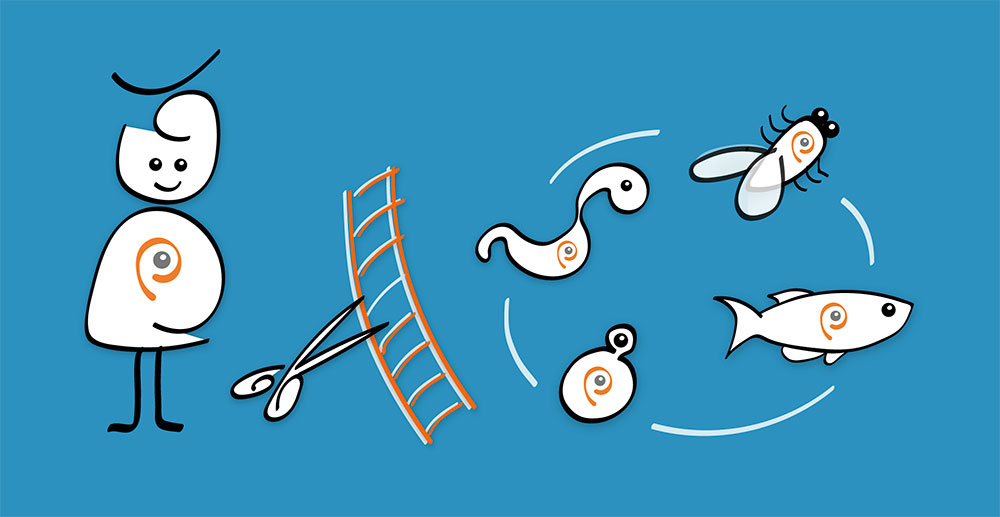On the first day of the new year, we submitted a new NGLY1 model preprint titled “Defects in the neuroendocrine axis cause global developmental delay in a Drosophila model of NGLY1 Deficiency.” Follow on Twitter.
Here I will explain in plain English what the NGLY1 community can learn from the humble fly (Drosophila melanogaster) and how we came to work on a fly model of NGLY1 Deficiency.
For the non-experts out there, a preprint is the first online version of a manuscript before peer review and revision at a scholarly journal. Preprints in biology are uploaded to a preprint server called biorXiv (pronounced “bio-archive”), which is taking off in popularity with researchers around the world.

Sharing new results accelerates research
Sharing new results – even if some of the time these results are overturned – accelerates research because both breakthrough and fool’s gold are exposed alike for all to see.
Perlara’s connection to NGLY1 began almost four years ago in the spring of 2014 when I first met GSF founder and president Matt Wilsey. He told me everything there was to know about NGLY1 at the time, which was basically the collected works of one brilliant and persistent scientist, Dr. Tadashi Suzuki, the discoverer of NGLY1 enzymatic activity in tissue culture cells in 1993 and a key member of the GSF researcher network today.
NGLY1 is an ancient gene. Brewer’s yeast – the simplest animal – has an ancient version of NGLY1. Several rungs up the evolutionary ladder, dirt-dwelling worms called nematodes have a version of NGLY1. And, of course, so do vinegar flies (also referred to as fruit flies).

Comparison of NGLY1 proteins across the animal kingdom, from yeast to humans. Fly (D. melanogaster), mouse (M. musculus) and human NGLY1 proteins are very similar. From Suzuki, “Journal of Biochemistry, 2015”
New Perlara NGLY1 mutant fly parallels human presentation
The fly (D. melanogaster) version of the NGLY1 gene is called Pngl. We decided to make a new NGLY1 mutant fly (“ngly1PL”) modeled after a class of patient-derived mutations called nonsense, or premature stop, mutations, e.gs., R401X, R524X, R458fs.
In December 2015, Tamy Portillo Rodriguez and Tom Hartl (now at BioMarin) began the fly version of a natural history study of NGLY1 Deficiency. A Perlara blog post from that time described early results that became the basis of Figure 1 of the preprint.
We knew from the outset of a 2011 study by Tadashi Suzuki and colleagues that mutant flies with large deletions in Pngl have severe global developmental delay with only 1% of affected animals surviving embryonic and larval development to adulthood.
Our ngly1PL mutant also has global developmental delay but a less severe presentation with ~50% of animals surviving to adulthood. Our mutant fly takes longer to proceed through each stage of metamorphosis from embryo to larva to pupa to adult – and at each stage a fraction of affected animals dies. As larvae, affected animals (right) are smaller/skinnier than their unaffected siblings (left).

On the left are NGLY1 carrier larvae (heterozygotes), and on the right are NGLY1 affected larvae (homozygotes). NGLY1 affected larvae are ~75% the size of their unaffected siblings.
Unexpectedly, we observed that ngly1PL mutants that survive to adulthood are also smaller compared to unaffected sibs. Small body size can be caused by multiple defects in development, but it is noteworthy that flies, mice and humans lacking their versions of the NGLY1 gene are small as adults, too.
We completed the first natural history study in early-to-mid 2016, capped off with a critical experiment showing that when we put the human NGLY1 gene into the genomes of ngly1PL mutant flies they develop totally normally to adulthood, and are normal size (top two rows) in contrast to sham-treated controls (bottom two rows):

The bottom two rows are NGLY1 affected adult flies, which are display stunted growth and small body size. The top two rows are NGLY1 affected adult flies in which human NGLY1 was artificially expressed; these flies appear normal.
A drug therapy candidate?
By the end of 2016, we completed a proof-of-concept drug repurposing screen. We were retesting over a dozen hit compounds that allowed affected larvae to develop at the rate of their unaffected sibs.
After several rounds of retesting, we found the proverbial needle in a haystack: a single compound passed muster out of initial library of 2,650 compounds, which includes FDA approved drugs, research-use compounds and natural products.
The winner is… 20-hydroxyecdysone, or 20E short. 20E is a naturally occurring substance. In fact, it’s a hormone derived from cholesterol that is found in developing insects.

NGLY1 affected larvae treated with 20E grow just like their unaffected siblings.
As we explicitly state in the preprint, no one should order 20E online to treat NGLY1 Deficiency in people. So what does a developmental hormone produced by insect larvae have to do with kids who have NGLY1 Deficiency? As we explain in the discussion of the preprint, we don’t yet understand what 20E is doing to affected animals but we’re testing a range of hypotheses.
What we know for sure is that our ngly1PL fly is extremely sensitive to the toxic effects of the proteasome inhibitor and cancer drug called bortezomib, as are NGLY1-deficient worms and mouse and human cell models of NGLY1 Deficiency.

Top row is a dose response of NGLY1 unaffected larvae treated with the proteasome inhibitor and cancer drug bortezomib. Bottom row is a dose response of NGLY1 affected larvae treated with bortezomib.
In other words, vulnerability to proteasome stress appears to be a universal feature of NGLY1 Deficiency in all animals.
The NGLY1 PerlQuest continues with flies and worms
Next step: using flies (and nematodes!) to discover new lead compounds and a potential clinical candidate for NGLY1 Deficiency.
First published on Grace Science Foundation web site. Reposting courtesy of Grace Science Foundation, a funding partner of the NGLY1 PerlQuest.


